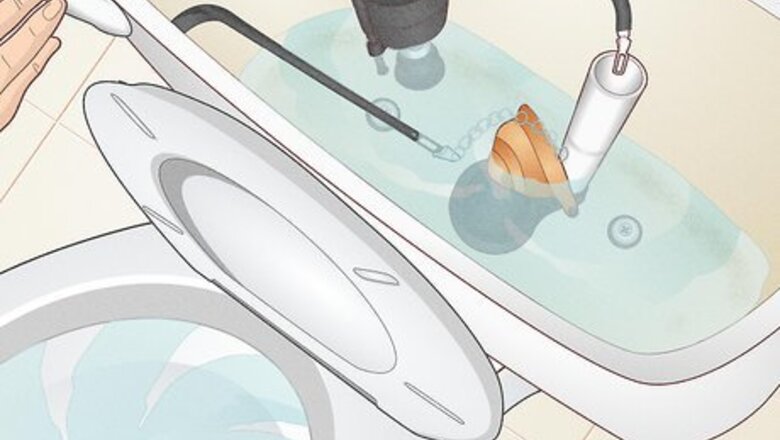
views
Drain the water in your toilet tank.
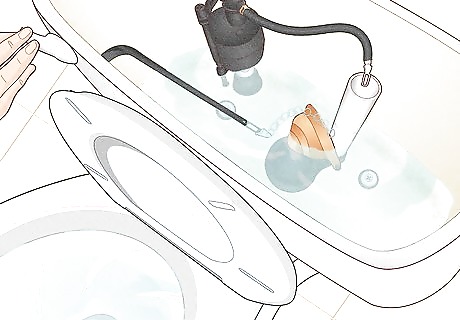
Turn off the water valve first. Look behind your toilet, where you'll find a handle attached to a pipe. Rotate it clockwise until it stops. The toilet tank will empty and fill up the bowl, instead. After you've cleaned the rust, turn the water valve back on. Rotate it counterclockwise until the tank fills up. When all the water is back in the tank, flush 3 or more times. Most rust-fighting techniques start with a tank that doesn't have water. That way, you can pinpoint all of the stains and easily access them. When you're done either scrubbing or soaking rust, you'll refill your tank and flush a few times. Leftover rust will loosen and go down the drains.
Scrub with scouring powder, cream of tartar, and hydrogen peroxide.
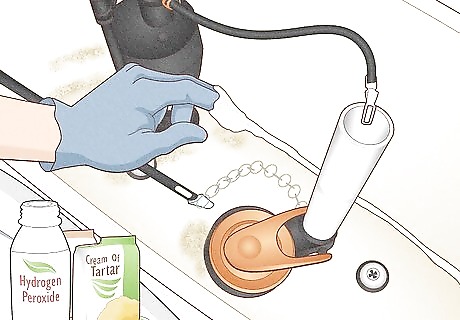
Create a cleaning paste with equal parts of each ingredient. Make sure the texture is slightly moist. Put on gloves and apply the paste on all the rust stains. Immediately scrub the rust. When you refill and flush the tank, the water will loosen up the paste so it can safely go down the drain. Scouring powder is an abrasive that breaks up hard particles. Cream of tartar is non-toxic and acidic, breaking down deposits like rust. Hydrogen peroxide breaks up caked on rust. Scrub and rinse the paste immediately since letting peroxide sit on the rust can make it worse.
Spray rust stains with white vinegar.
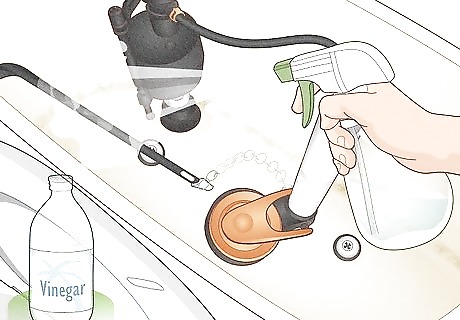
Let the white vinegar sit for 5-7 minutes, then scrub the rust with a sponge or a brush. For stubborn stains, wait 1 hour for the white vinegar to completely soak through the rust before you scrub it off. You can also fill your spray bottle with white vinegar, water, and dish soap. The acid in vinegar will break down rust, and the grease fighting dish soap can scrub away any slimy grime. Stick with white vinegar and avoid other types since they can stain the bowl. Even rice vinegar can result in light yellow marks. You can also add white vinegar directly into the tank water until the fluid sits roughly a ⁄2 in (1.3 cm) below the rim. Leave the toilet untouched for 12 to 24 hours, depending on the severity of the rust. Then, flush the toilet at least 3 or 4 times to clear away the vinegar.
Make a paste with lemon juice and salt.
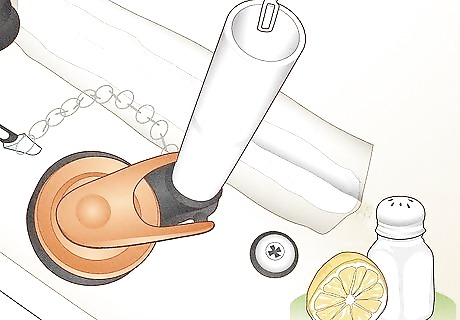
Stir equal parts salt and lemon juice in a small bowl. Dip your sponge in your bowl until it’s coated with paste, then scrub the rust stains in a circular motion. For super stubborn stains, cover the stained area with paste, cover the area with plastic wrap, and let the paste sit for up to an hour. Then, peel away the plastic wrap and scrub off the rust. Lime juice and grapefruit juice work, too. You can also combine citric acid powder with water to make a paste. Natural acids dissolve rust and salt is mildly abrasive, which helps when you're scrubbing.
Fill the tank with cola and wait 2 hours.
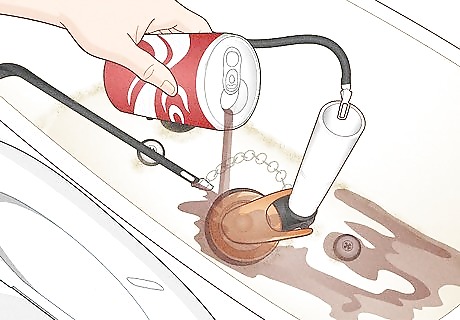
Pour 1 1.5 cups (350 ml) can of room temperature cola into your toilet tank. The phosphoric acid breaks down iron oxide in rust, dissolving stains. Soak rust stains in cola for about 2 hours for the best results. For stubborn stains, wait 24 hours. Then, scrub the stains with a toilet brush. Cola is an eco-friendly cleaning solution, but since it has a low level of phosphoric acid, it takes longer to dissolve stains than other cleaning chemicals. Warm cola dissolves stains more effectively.
Sprinkle an oxalic acid cleaner on rust stains.
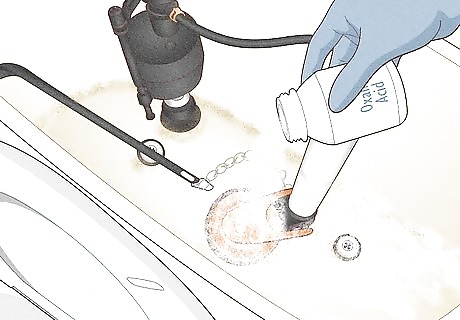
Wear a mask and turn the fan on in your bathroom to ventilate it. Take the lid off your tub of oxalic acid, and shake the powder or flakes onto the rust stains. Set down the tub, dampen a cloth with warm water, and spread the oxalic acid on every side of your toilet tank. Wait for 1-2 minutes. Don’t get oxalic acid on your skin, eyes, or clothing. Exposing yourself or others to it can lead to chemical burns. A mask will keep you from breathing it in. Oxalic acid breaks down the iron in rust, softening it and making it easy to rinse off.
Scrub the rust with a multipurpose commercial cleaner.

Pour about .03 cups (7.1 ml) of water into your empty toilet tank. Add .03 cups (7.1 ml) of the multipurpose cleaner to the water. Use a clean toilet brush to mix the solution. Soak the brush, then scrub your rust stains. Wear safety glasses to protect your eyes from splashes and gloves to protect your hands from the harsh chemicals. Use a toothbrush for hard to reach stains. Many multipurpose cleaners are designed for tough stains on hard surfaces and can loosen up sticky deposits like rust.
Clean your toilet tank twice a year to keep it rust-free.
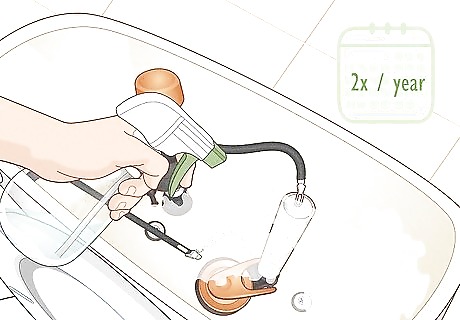
You can prevent rust buildup by deep cleaning every 6 months. The iron from hard water can build up over time, leading to lots of rust deposits in your toilet tank. If you make sure to wash and scrub your toilet tank, rust has less of a chance to form.
Pour in a liquid water softener product to prevent rust.
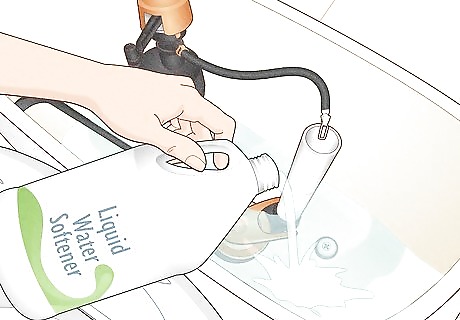
Adding softener to the tank every month or so can prevent rust buildup. Read your product’s label to determine the correct amount of softener to use and the total time it should stay in your tank. Empty your toilet tank, pour in the commercial liquid water softener, wait for it to settle, brush down your tank, then refill it with water and flush. For a natural alternative to chemical water softeners, pour 1 cup (236 ml) of lemon juice or vinegar in your toilet tank. Let it sit for at least 3 hours before flushing. Do this daily to keep rust stains from forming.
Toss a commercial cleaning tablet into the tank once a month.
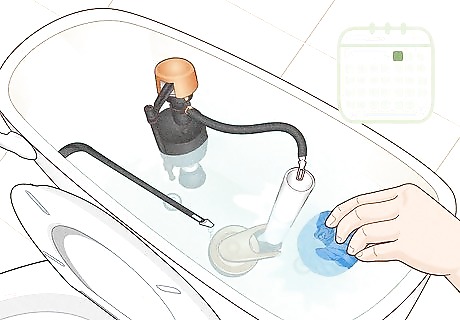
These simple cleaners can help prevent rust build up. You can use any specially formulated drop-in cleaner (they're usually sold as tablets, cubes, or packets). Each flush will activate the drop-ins’ chemicals to fight hard water deposits and prevent rust. Use non-toxic, bleach-free drop-ins. Drop-ins "outgas" when they release stain fighting chemicals, so avoid drop-ins that release anything you shouldn't be breathing. There are also eco-friendly, chemical-free drop-ins on the market, too.




















Comments
0 comment